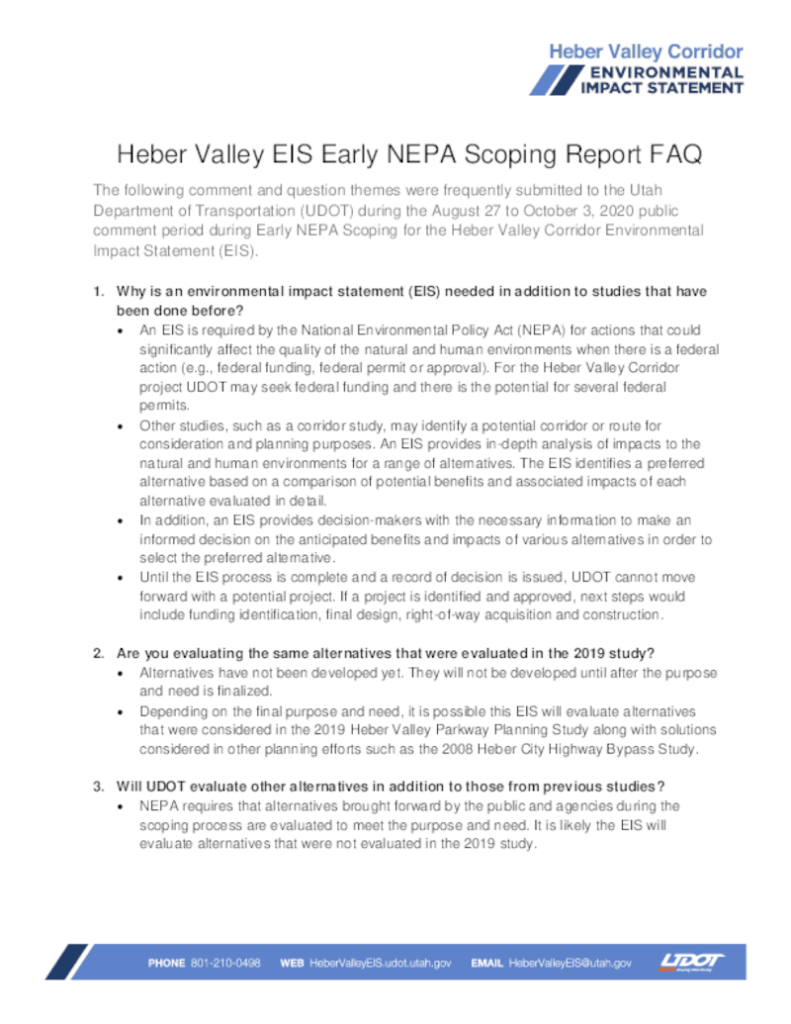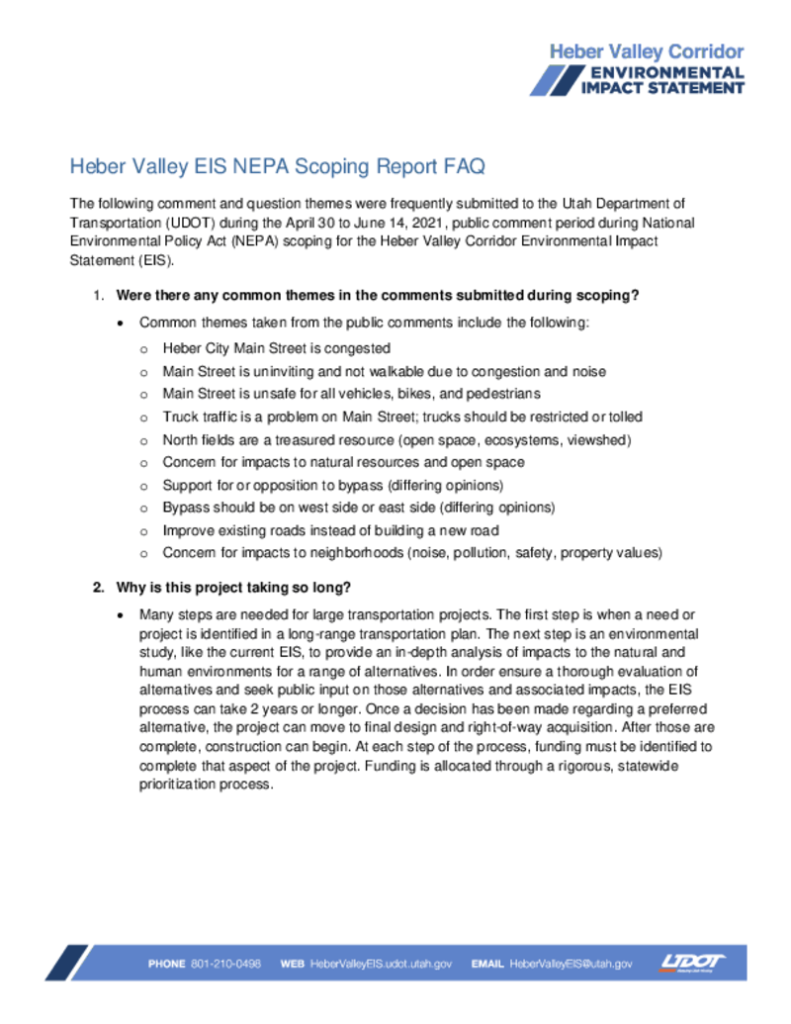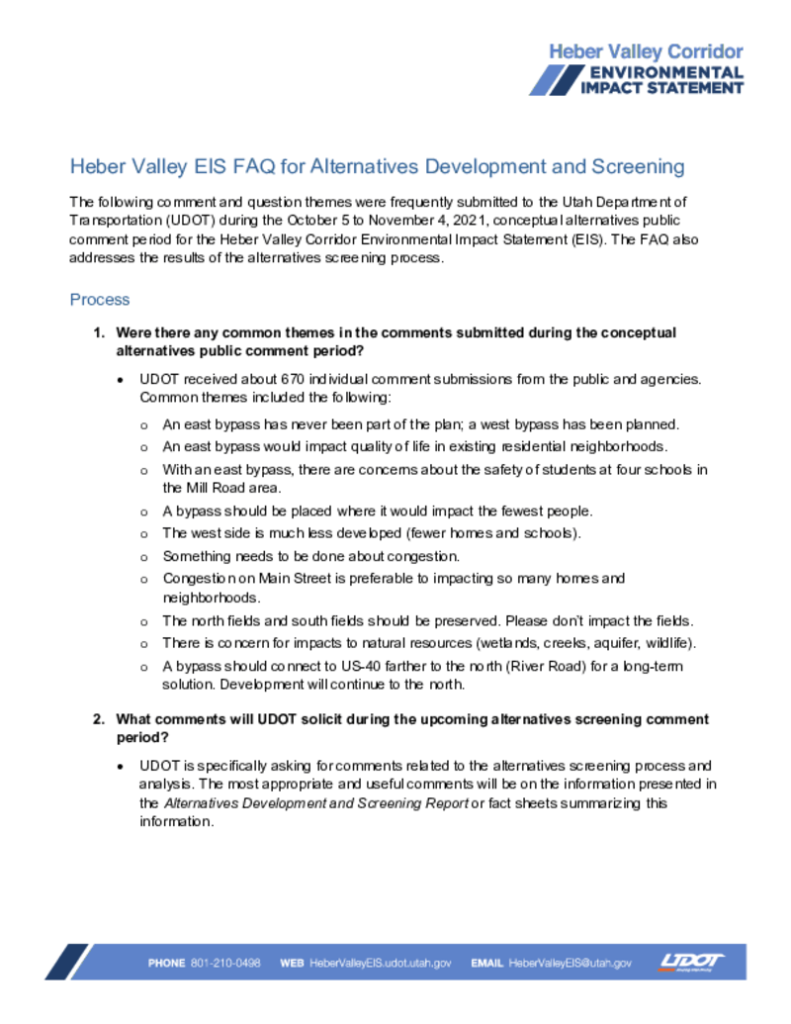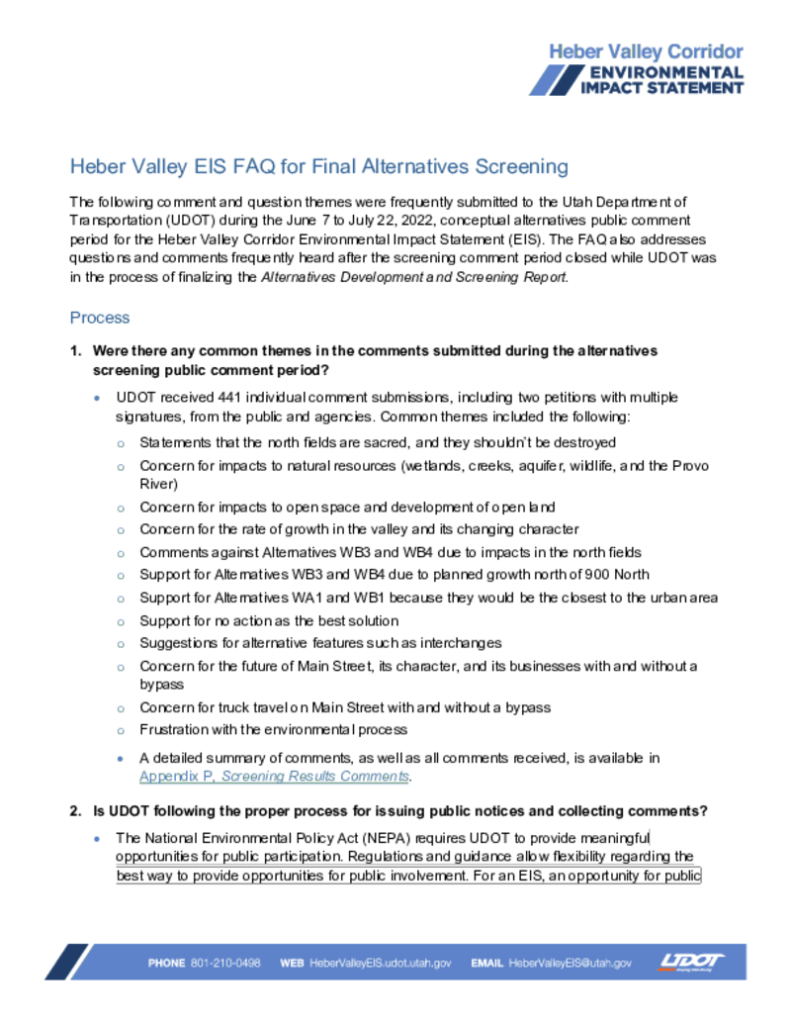Environmental Impact statement
Why did UDOT conduct a preliminary Corridor Planning Study before the EIS?
- UDOT conducts planning studies early in the project development process to help determine if there is a need to progress a project into the environmental stage. It also helps UDOT identify potential issues to better understand a project before moving it forward.
- One purpose of planning studies is to preserve corridors in rapidly-developing areas. However, corridor preservation does not predetermine the outcome of the EIS process but does allow local jurisdictions some level of future planning.
- In addition, the preliminary study helped UDOT build stakeholder relationships and learn stakeholder needs.
- Conducting a planning study also allowed UDOT to clearly identify a need for further environmental study and inform that study of key issues and recommendations.
Why is an EIS needed in addition to studies that have been done before?
- An EIS is required by the National Environmental Policy Act (NEPA) for actions that could significantly affect the quality of the natural and human environments when there is a federal action (e.g., federal funding, federal permit or approval).
- Other studies, such as a corridor study, may identify a potential corridor or route for consideration and planning purposes. An EIS provides in-depth analysis of impacts to the natural and human environments for a range of alternatives. The EIS identifies a preferred alternative based on a comparison of potential benefits and associated impacts of each alternative evaluated in detail.
- In addition, an EIS provides decision-makers with the necessary information to make an informed decision on the anticipated benefits and impacts of the action.
What agencies are involved with the EIS and what roles will they have?
- UDOT is the project sponsor and the lead agency on the EIS, responsible for things such as:
- Managing the process and resolving issues.
- Identifying and involving cooperating and participating agencies.
- Providing opportunities for public involvement in defining the purpose of and need for the project.
- Determining the range of alternatives and determining methodologies and the level of detail for the analysis of alternatives.
- As the lead agency, UDOT is responsible for the decision on the preferred alternative and whether to move forward with an action.
- UDOT has assumed the Federal Highway Administration’s (FHWA) responsibilities under NEPA. The environmental review, consultation, and other actions required by applicable Federal environmental laws for this project are being, or have been, carried out by UDOT pursuant to 23 U.S.C. 327 and a Memorandum of Understanding dated May 26, 2022, and executed by FHWA and UDOT.
- Part of the process is engaging with cooperating and participating agencies, stakeholders and the public. UDOT will be engaging with all those groups in various ways.
- A cooperating agency is an agency or tribe, other than a lead agency, that has jurisdiction by law or special expertise with respect to any environmental impact involved in a proposed project or project alternative. A state or local agency of similar qualifications may, by agreement with the lead agency, become a cooperating agency.
- A participating agency is a federal, state, tribal, regional, or local government agency that might have an interest in the project.
- Key stakeholders are audiences that are integral to achieving the study’s objectives and goals. The range of stakeholders may be expanded as the study develops.
What are some environmental considerations that the EIS will assess?
- Air quality
- Residential and commercial property impacts
- Economic development
- Hazardous materials
- Historic structures
- Land use
- Noise
- Potential construction impacts
- Social (e.g., emergency services, neighborhood unity and community character)
- Wildlife and threatened and endangered species
- Wetlands
What are some transportation considerations that the EIS will assess?
- Preferred alternatives are not determined based on the amount of positive or negative comments received.
- Commenting is not a vote on an alternative or action but a way for the public to provide the project team with information for consideration in the NEPA decision-making process.
- Decisions will be made by following the process, utilizing best available data including public input.
- Comments received outside of the Draft EIS formal comment period will be documented in the project record but will not be formally responded to or included in the Final EIS.
- Only responses to comments made during the Draft EIS formal comment period will be included in the Final EIS.
- Social media discussions are not part of the official EIS record, but they provide insightful information and help the team make the most informed transportation decisions for the Heber Valley study area.
- As the EIS progresses, the project team will update the public on the current status of the project and provide notice when new information will be available.
Why are some alternatives still being considered when community representatives have stated an opposition to them?
- The National Environmental Policy Act (NEPA) process requires that UDOT evaluate a reasonable range of alternatives and provide an opportunity for public input on those alternatives.
- For example, UDOT received numerous comments that a bypass should be extended farther to the north to account for planned development and growth on north US-40 and that a bypass that ties into US-40 at 800 North is not a long-term solution because of that planned growth.
- UDOT is required to consider these comments, regardless of support or opposition.
- The range of alternatives under consideration allows an examination of the impacts and tradeoffs of improving regional mobility by upgrading north US-40 on its existing alignment, providing a new connection, and comparing those alternatives against not making any improvements.
- Only by evaluating the full range of alternatives can UDOT make an informed decision that will result in the best solution overall.
- Ignoring potential alternatives or dismissing them prematurely would not result in a full examination of impacts and tradeoffs and would leave the process open to legal risk.
- The screening process determines which alternatives will move forward for detailed evaluation and, at this stage, UDOT will eliminate alternatives only based on screening criteria that identify them as clearly not reasonable. Reasonable alternatives are those that are technically and economically feasible, rather than simply desirable.
- Level 1 screening criteria evaluate how well an alternative meets the project purpose.
- Level 2 screening criteria evaluate impacts to key resources including wetlands.
- Alternatives that pass through screening will be evaluated in detail in the Draft EIS.
- The Draft EIS analysis is when detailed impacts to open space, visual impacts, water quality, wildlife, community impacts, and so on, will be evaluated. The results of this detailed evaluation will inform UDOT’s selection of a preferred alternative.
- UDOT can’t eliminate alternatives for impacts to these resources during screening because the analysis has not been done yet.
Public Involvement
What opportunities are there for public involvement during the EIS process?
- The EIS project team encourages public involvement throughout each phase of the study and will consider public input in developing the EIS as well as to support the decision-making process.
- This EIS will feature a robust public process, including formal public comment periods, public meetings, solicitation of public input, email updates and notifications, and project information shared on social media channels and the project website.
- Preferred alternatives are not determined based on the amount of positive or negative comments received.
- Commenting is not a vote on an alternative or action, but a way for the public to provide the project team with information for consideration in the NEPA decision-making process.
- Decisions will be made by following the process, utilizing best available data including public input.
- Comments received outside of the Draft EIS formal comment period will be documented in the project record but will not be formally responded to or included in the Final EIS.
- Only responses to comments made during the Draft EIS formal comment period will be included in the Final EIS.
- Social media discussions are not part of the official EIS record, but they provide insightful information and help the team make the most informed transportation decisions for the Heber Valley study area.
- Outside of the formal NEPA public comment periods, the EIS team will update the public on the current status of the project and provide notice when new information will be available.
How are public comments used?
- Preferred alternatives are not determined based on the amount of positive or negative comments received.
- Commenting is not a vote on an alternative or action but a way for the public to provide the project team with information for consideration in the NEPA decision-making process.
- Decisions will be made by following the process, utilizing best available data including public input.
- Comments received outside of the Draft EIS formal comment period will be documented in the project record but will not be formally responded to or included in the Final EIS.
- Only responses to comments made during the Draft EIS formal comment period will be included in the Final EIS.
- Social media discussions are not part of the official EIS record, but they provide insightful information and help the team make the most informed transportation decisions for the Heber Valley study area.
- As the EIS progresses, the project team will update the public on the current status of the project and provide notice when new information will be available.




